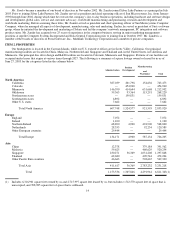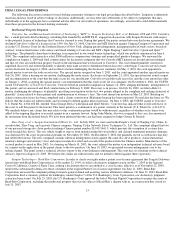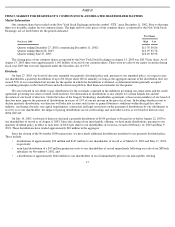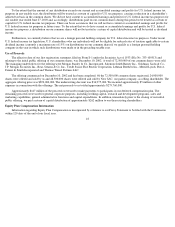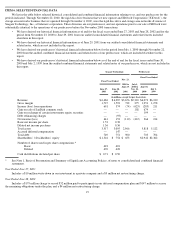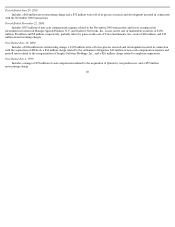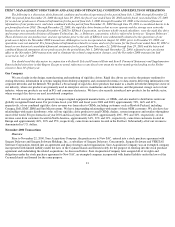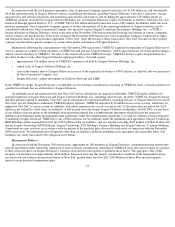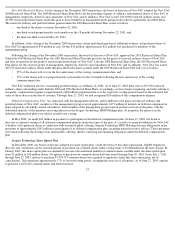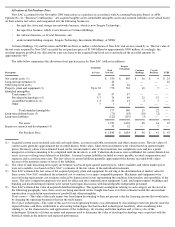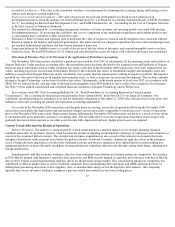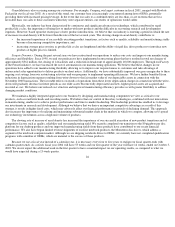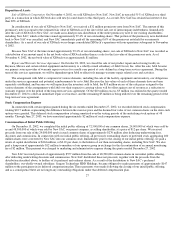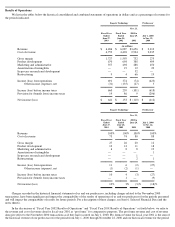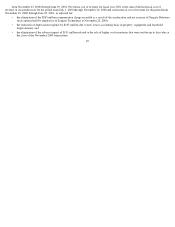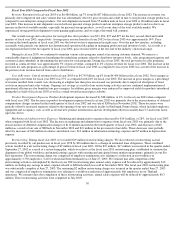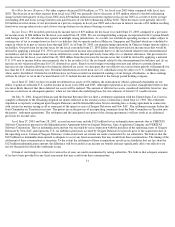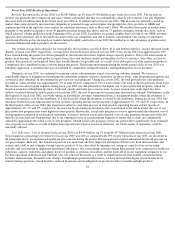Seagate 2002 Annual Report Download - page 27
Download and view the complete annual report
Please find page 27 of the 2002 Seagate annual report below. You can navigate through the pages in the report by either clicking on the pages listed below, or by using the keyword search tool below to find specific information within the annual report.
Allocation of Net Purchase Price
New SAC accounted for the November 2000 transactions as a purchase in accordance with Accounting Principles Board, or APB,
Opinion No. 16, “Business Combinations.”
All acquired tangible assets, identifiable intangible assets and assumed liabilities were valued based
on their relative fair values and reorganized into the following businesses:
•
the rigid disc drive and storage area networks business, which is now Seagate Technology;
•
the tape drive business, which is now known as Certance Holdings;
•
the software business, or Crystal Decisions; and
Certance Holdings, Crystal Decisions and STIH are direct or indirect subsidiaries of New SAC and are not owned by us. The fair value of
the net assets acquired by New SAC exceeded the net purchase price of $1.840 billion by approximately $909 million. Accordingly, the
resultant negative goodwill was allocated on a pro rata basis to the acquired long-lived assets and reduced the recorded amounts by
approximately 46%.
The table below summarizes the allocation of net purchase price by New SAC (dollars in millions).
Trade names —The value of the trade names was based upon discounting to their net present value the licensing income that would arise
by charging the operating businesses that use the trade names.
Developed technologies—The value of this asset for each operating business was determined by discounting to their net present value the
expected future cash flows attributable to all existing technologies that had reached technological feasibility, after considering risks
relating to: (a) the characteristics and applications of the technology, (b) existing and future markets and (c) life cycles of the
technologies. Estimates of future revenues and expenses used to determine the value of developed technology were consistent with the
historical trends in the industry and expected performance.
•
an investment holding company, Seagate Technology Investments Holdings, or STIH.
Description
Useful Life
in Years
Total
New SAC
Seagate
Technology
Certance
Holdings
Crystal
Decisions
STIH
Net current assets (1)
$
939
$
869
$
36
$
9
$
25
Long
-
term investments (2)
42
—
—
—
42
Other long
-
lived assets
42
42
—
—
—
Property, plant and equipment (3)
Up to 30
778
763
10
5
—
Identified intangibles:
Trade names (4)
10
47
47
—
—
—
Developed technologies (4)
3
-
7
76
49
12
15
—
Assembled workforces (4)
1
-
3
53
43
3
7
—
Other
5
1
1
—
—
—
Total identified intangibles
177
140
15
22
—
Long
-
term deferred taxes (5)
(75
)
(63
)
(10
)
(2
)
—
Long
-
term liabilities
(122
)
(119
)
(3
)
—
—
Net assets
1,781
1,632
48
34
67
In
-
process research and development (4)
59
52
—
7
—
Net Purchase Price
$
1,840
$
1,684
$
48
$
41
$
67
(1)
Acquired current assets included cash and cash equivalents, accounts receivable, inventories and other current assets. The fair values of
current assets generally approximated the recorded historic book values. Short-term investments were valued based on quoted market
prices. Inventory values were estimated based on the current market value of the inventories less completion costs and less a profit
margin for activities remaining to be completed until the inventory is sold. Valuation allowances were established for current deferred tax
assets in excess of long-term deferred tax liabilities. Assumed current liabilities included accounts payable, accrued compensation and
expenses and accrued income taxes. The fair values of current liabilities generally approximated the historic recorded book values
because of the monetary nature of most of the liabilities.
(2)
The value of individual long-term equity investments was based upon quoted market prices, where available, and where market prices
were not available, was based on New SAC
’
s estimates of the fair values of the individual investments.
(3)
New SAC estimated the fair value of the acquired property, plant and equipment. In arriving at the determination of market value for
these assets, New SAC considered the estimated cost to construct or acquire comparable property. Machinery and equipment were
assessed using replacement cost estimates reduced by depreciation factors representing the condition, functionality and operability of the
assets. The sales comparison approach was used for office and data communication equipment. Land, land improvements, buildings and
building and leasehold improvements were valued based upon discussions with knowledgeable independent personnel.
(4)
New SAC estimated the value of acquired identified intangibles. The significant assumptions relating to each category are discussed in
the following paragraphs. Also, these assets are being amortized on the straight-line basis over their estimated useful life and resultant
amortization is included in amortization of goodwill and other intangibles.


